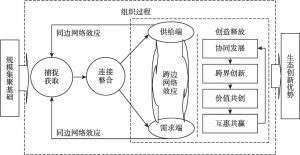摘要
平台企业及其构建的商业生态圈具有强大的生命力,但平台企业撬动生态圈中的资源和能力形成生态优势的原理尚未解释清楚。本文以京东为例,通过案例研究,从平台企业发展的不同阶段探索生态优势形成路径。研究发现,平台企业生态优势的形成是一个循序渐进的过程;不同生命周期阶段的形成路径各不相同,初创期通过捕捉获取形成安装基础优势,发展期通过集成整合形成规模集聚优势,成熟期通过创造释放形成生态创新优势,三个阶段构筑的基础共同推动生态优势的形成。研究提炼出了生态优势形成的路径模型,进一步丰富了企业优势理论,还对传统企业转型升级、平台化战略布局及商业生态圈构建具有实践指导意义。
作者
张镒 ,暨南大学管理学院博士研究生,主要研究方向为平台战略管理与技术创新。
刘人怀 ,暨南大学战略管理研究中心教授、博士生导师,中国工程院院士,主要研究方向为战略管理。
陈海权 ,暨南大学管理学院教授、博士生导师,主要研究方向为商业经济。
- [1]蔡宁、王节祥、杨大鹏:《产业融合背景下平台包络战略选择与竞争优势构建——基于浙报传媒的案例研究》,《中国工业经济》2015年第5期。
- [2]李雷、赵先德、简兆权:《网络环境下平台企业的运营策略研究》,《管理科学学报》2016年第3期。
- [3]李文莲、夏健明:《基于“大数据”的商业模式创新》,《中国工业经济》2013年第5期。
- [4]廖建文、崔之瑜:《企业优势矩阵:竞争 vs 生态》,《哈佛商业评论》2016年第7期。
- [5]潘松挺、杨大鹏:《企业生态圈战略选择与生态优势构建——以乐视控股为例》,《科技进步与对策》2017年第21期。
- [6]汪旭晖、张其林:《平台型电商企业的温室管理模式研究——基于阿里巴巴集团旗下平台型网络市场的案例》,《中国工业经济》2016年第11期。
- [7]吴昌南:《城市晚报:定价、虚假发行量与规制政策——基于双边平台理论的视角》,《中国工业经济》2014年第2期。
- [8]徐鹏杰:《互联网时代下企业竞争范式的转变:从竞争优势到生态优势——以韩都衣舍为例》,《中国人力资源开发》2017年第5期。
- [9]张小宁:《平台战略研究评述及展望》,《经济管理》2014年第3期。
- [10]Abbott,K.W.,Green,J.F.,and Keohane,R.O.,“Organizational Ecology and Institutional Change in Global Governance”,International Organization,70(2),2016:247-277.
- [11]Adner,R.,and Zemsky,P.,“A Demand-based Perspective on Sustainable Competitive Advantage”,Strategic Management Journal,27(3),2006:215-239.
- [12]Afuah,A.,“Mapping Technological Capabilities Into Product Markets and Competitive Advantage:the Case of Cholesterol drugs”,Strategic Management Journal,23(2),2002:171-179.
- [13]Ansari,S.,Garud,R.,and Kumaraswamy,A.,“The Disruptor’s Dilemma:Tivo and the U.S.Television Ecosystem”,Strategic Management Journal,37(9),2016:1829-1853.
- [14]Barney,J.B.,“Firm Resource and Sustained Competitive Advantage”,Journal of Management,17(1),1991:99-120.
- [15]Bellman,R.,Clark,C.E.,Malcolm,D.G.,Malcom,D.G.,and Ricciardi,C.F.M.,“On the Construction of A Multi-stage,Multi-person Business Game”,Operations Research,5(4),1957:469-503.
- [16]Bogers,M.,Hadar,R.,Bilberg,A.,“Additive Manufacturing for Consumer-centric Business Models:Implications for Supply Chains in Consumer Goods Manufacturing”,Technological Forecasting and Social Change,102,2016:225-239.
- [17]Caillaud,B.,Jullien,B.,“Chicken & Egg:Competition Among Intermediation Service Providers”,Rand Journal of Economics,34(2),2003:309-328.
- [18]Cennamo,C.,Santalo,J.,“Platform Competition:Strategic Trade-offs in Platform Markets”,Strategic Management Journal,34(11),2013:1331-1350.
- [19]Cottrell,T.,Nault,B.R.,“Product Variety and Firm Survival in the Microcomputer Soffware Industry”,Stratogic Managemont Journal,25(10),2004:1005-1025.
- [20]Eisenhardt,K.M.,“Building Theories from Case Study Research”,Academy of Management Review,14(4),1989:532-550.
- [21]Gambardella,A.,Raasch,C.,Von Hippel,E.,“The User Innovation Paradigm:Impacts on Markets and Welfare”,Management Science,63(5),2017:1450-1468.
- [22]Hanna,R,Rohm,A.,and Crittenden,V.L.,“We’re All Connected:the Power of the Social Media Ecosystem”,Business Horizons,54(3),2011:265-273.
- [23]Mcintyre,D.P.,Srinivasan,A.,“Networks,Platforms,and Strategy:Emerging Views and Next Steps”,Strategic Management Journal,38(1),2017:141-160.
- [24]Moore,J.F.,“Predators and Prey:a New Ecology of Competition”,Harvard Business Review,71(3),1993:75-86.
- [25]Penrose,E.T.,The Theory of the Growth of the Firm(Oxford:Oxford University Press,1995).
- [26]Pierce,L.,“Big Losses in Ecosystem Niches:How Core Firm Decisions Drive Complementary Product Shakeouts”,Strategic Management Journal,30(3),2009:323-347.
- [27]Porter,M.E.,Competitive Advantage(New York:Free Press,1985).
- [28]Prahalad,C.K.,and Hamel,G.,“The Core Competence of the Corporation”,Harvard Business Review,68(3),1990:275-292.
- [29]Rochet,J.C.,Tirole,J.,“Platform Competition in Two-sided Markets”,Journal of the European Economic Association,1(4),2003:990-1029.
- [30]Rochet,J.C.,and Tirole,J.,“Two-sided Markets:An Overview”,Toulouse,51(11),2004:233-260.
- [31]Rochet,J.C.,and Tirole,J.,“Two-sided Markets:A Progress Report”,Rand Journal of Economics,37(3),2006:645-667.
- [32]Sekhar,J.A.,and Dismukes,J.R.,“Generic Innovation Dynamics Across the Industrial Technology Life Cycle Platform Equation Modeling of Invention and Innovation Activity”,Technological Forecasting and Social Change,76(1),2009:192-203.
- [33]Siggelkow,N.,“Persuasion with Case Studies”,Academy of Management Journal,50(1),2007:20-24.
- [34]Tiwana,A.,Konsynski,B.,and Bush,A.A.,“Platform Evolution:Coevolution of Platform Architecture,Governance,and Environmental Dynamics”,Information Systems Research,21(4),2010:675-687.
- [35]Van de Ven,A.H.,Engaged Scholarship:A Guide for Organizational and Social Research(Oxford,UK:Oxford University Press,2007).
- [36]Wernerfelt,B.A.,“Resource-based View of the Firm”,Strategic Management Journal,5(2),1984:171-180.
- [37]Yadav,P.L.,Han,S.H.,and Kim,H.,“Sustaining Competitive Advantage Through Corporate Environmental Performance”,Business Strategy and the Environment,26(3),2017:345-357.
- [38]Yin,R.K.,Case Study Research:Design and Methods(Los Angeles:Sage Publications,2009).












